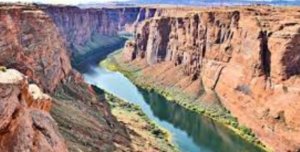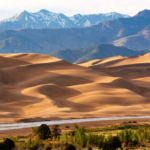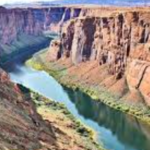The term stream includes the channelized flow of any size, from the smallest brook to a very large river like the Amazon. Although the terms “river” and “steam” are used synonymously, the term “river” is preferably used to denote a mainstream into which several tributaries flow.
Read: Features of Stream Erosion
The geological work of the stream is to “erode” the valleys, “transport” the material that is eroded, and “deposit” the same in the lower reaches at favorable sites.

Stream Erosion
The steam causes erosion in four ways; (i) chemical action, (ii) hydraulic action, (iii) abrasion, and (iv) attrition.
- Chemical Action: It includes the solvent and chemical action of water on country rocks. The chemical decay works along joints and cracks and thus helps in breaking the bedrock.
- Hydraulic Action: The swiftly flowing water hammers the uneven faces of jointed rocks exposed along its channel and removes the jointed blocks. This process of erosion is called “hydraulic action”. At the bottom of waterfalls, the channels are eroded at an enormously rapid ratio by hydraulic action.
- Abrasion: The flowing water uses rock fragments such as pebbles, gravel, and sand as a tool for scratching and grinding the sides and floor of the valley. This process of erosion is called “abrasion”.
- Attrition: It is the breaking of the transported materials themselves due to mutual collision. the attrition causes the rock fragment to become more rounded and smaller in size.
In addition to the above, the streams acquire their load by many other means. Much of the material carried by a stream is contributed by underground water, overland flow, and mass wasting.
Stream Transportation
The amount of solid material transported by a stream is called its “load”. The streams transport it in three ways: (i) in solution (dissolved load), (ii) in suspension (suspended load), (iii) along the bottom (bed load).
- Dissolved Load: The dissolved load is brought to the stream by groundwater. Some amount of it is also acquired directly from soluble rocks which occur along the stream’s course.
- Suspended Load: Suspended load forms the major portion of the load carried by streams. Usually only smaller particles such as clay and silt travel in suspension, but during floods much larger particles are carried this way.
- Bed Load: The forward force of moving water acts more directly on the larger grains at the bottom, pushing, rolling, and sliding them along. The particles moved in this way constitute the “bed load” of a stream. Locally the medium-sized material may travel partly by rolling as bed load and partly in suspension. This process of intermitted jumping is called “saltation”. In solution, the heavy particles are lifted occasionally for a few seconds by a swift eddy.
The velocity of a stream is affected by a number of factors, including gradient, channel size and shape, load, and discharge. The increase in velocity increases the transporting power of a river as much as the 6th power of velocity.
Transporting Power ∝ V6
It means that during floods the transporting power of a stream suddenly rises very much and it becomes capable of moving big boulders which would otherwise remain quite immovable.
Deposition by Steam
The loose rock materials transported by a stream downstream, are deposited where the velocity of flowing water is reduced. The sorting of the material takes place automatically as the large and heavier particles settle quickly while the smaller and lighter ones continue their journey further ahead. The material, which a stream deposits as sediment is called “alluvium” or “alluvial deposits”.
Other posts you may like:
- Great Sand Dunes National Park
- Erosion Control Blanket
- Sand Dunes and different types of Sand Dunes
- Wind Erosion


Leave a Reply